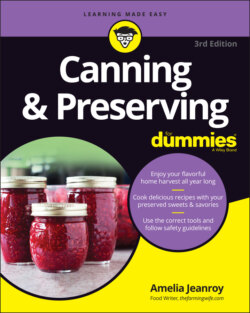Читать книгу Canning & Preserving For Dummies - Amelia Jeanroy - Страница 20
Holding the Keys to Canning and Preserving Success
ОглавлениеCanning and preserving methods are simple and safe, and they produce food that’s nutritious, delicious, and just plain satisfying to your taste buds. Becoming a successful food preserver takes time, effort, and knowledge of the rules. Follow these tips for achieving success as a home canner and preserver:
Start with the freshest, best products available. Preserving doesn’t improve food quality. If you put garbage in, you get garbage out.
Know the rules and techniques for your canning or preserving method before you start your work. Don’t try to learn a technique after you’ve started your processing.
Work in short sessions to prevent fatigue and potential mistakes. Process no more than two items in one day, and work with only one canning method at a time.
Stay up to date on new or revised guidelines for your preserving method. This book is a great start. You can also go to websites like
www.freshpreserving.com, created by the makers of Ball canning supplies. Here you can find tips and directions for canning just about anything.Use the correct processing method and processing time to destroy microorganisms. The recipe will tell you what method to use, but it helps if you understand the difference between high- and low-acid foods and how the canning methods for each differ. Go to Chapter 3 for details.
Know the elevation you’re working at. Adjust your processing time or pressure when you’re at an altitude over 1,000 feet above sea level. For accurate information on how to adjust for your altitude, refer to Chapter 4 for water-bath canning conversions and Chapter 9 for pressure canning conversions.
Put together a plan before you start your preserving session. Read your recipe (more than once). Have the proper equipment and correct ingredients on hand to prevent last-minute shortages and inconvenient breaks (make a list of what you need and check off items as you gather them).
Test your equipment. If you’re using a pressure canner or an electric dehydrator, test out the equipment to ensure everything’s working properly. And always check the seals on your jars.
Do a trial run. Before canning for the first time (or the fortieth), it’s a good idea to do a trial run. Canning jars of water is a great way to be certain that you have all the equipment you will need, and that you are using the techniques properly. Do your jars seal? It is also a good way to experience the sounds that both a water-bath and pressure canner make.
Use recipes from reliable sources or ones that you’ve made successfully before. Follow your recipe to the letter. Don’t substitute ingredients, adjust quantities, or make up your own food combinations. Improvisation and safe food preservation aren’t compatible. It is important to know that when canning, you can’t double your recipe. If you require more than what the recipe yields, make another batch. Always use the size jars that are recommended in the recipe as well. Trying to use a larger or smaller jar may throw off the yield and final result.
Now you’re ready to take your food to its final destination in the preservation process. Whether you choose canning, freezing, or dehydrating, proceed down your canning and preserving road with confidence.
